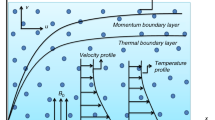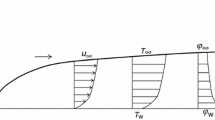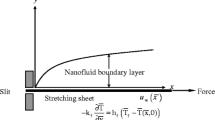Abstract
The fully developed boundary layer flow and heat transfer model of an unsteady, incompressible, electrically conducting, optically thick and thermodynamically compatible third-grade nanofluid are investigated from the viewpoint of Lie symmetry approach. We have studied the Stokes’ model in which flow is generated due to motion of the bounding surface with an impulsive time-dependent velocity. The mathematical model also includes the effect of thermal radiation and internal heat source or sink in the flow regime. Lie symmetry approach is employed to obtain the symmetry algebra of the governing nonlinear partial differential equations for both flow and heat transfer models. The governing nonlinear partial differential equations describing the flow and heat transfer model are reduced to different classes of nonlinear ordinary differential equations under the implication of symmetry generators. The reduced ordinary differential equations are investigated using the compatibility and generalized group theoretical method. The exact closed-form solutions for nanofluid motion and temperature distribution within the boundary layer are obtained. The effect of various thermophysical parameters on the characteristics of flow and heat transfer for Cu-water nanofluid model is explored from a physical point of view.
















Similar content being viewed by others
References
Choi S. Enhancing thermal conductivity of fluids with nanoparticles. ASME Int Mech Eng Congress Expos. 1995;66:66–99.
Eastman J, Choi S, Li S, Yu W, Thompson L. Anomalously increases effective thermal conductivities of ethylene glycol-bases nano fluids containing copper nanoparticles. Appl Phys Lett. 2001;78:718–20.
Keblinski P, Phillpot S, Choi S, Eastman J. Mechanisms of heat flow in suspensions of nano-sized particles (nanofluids). Int J Heat Mass Transf. 2002;45:855–83.
Naseem A, Mahmood A, Siddique JI, Zhao L. Axisymmetric magnetohydrodynamic flow of nanofluid under heat generation/absorption effects. Appl Math Sci. 2017;11:2059–87.
Mahmood A, Aziz A, Jamshed W, Hussain S. Mathematical model for thermal solar collectors by using magnetohydrodynamic maxwell nanofluid with slip conditions, thermal radiation and variable thermal conductivity. Res Phys. 2017;7:3425–33.
Patil PM, Shashikant A, Momoniat E, Harley C. Numerical simulation of unsteady triple diffusive mixed convection in NaCl-water and Sucrose-water solutions. Int J Heat Mass Transf. 2018;126:147–55.
Yao S, Fang T, Zhong Y. Heat transfer of a generalized stretching/shrinking wall problem with convective boundary conditions. Commun Nonlinear Sci Numer Simul. 2010;16:752–60.
Kumar M, Chandrasekar PCM. Heat transfer and friction factor analysis of MWCNT nanofluids in double helically coiled tube heat exchanger. J Therm Anal Calorim. 2020;. https://doi.org/10.1007/s10973-020-09444-x.
Dabiri E, Bahrami F. Experimental investigation on turbulent convection heat transfer of SiC/W and MgO/W nanofluids in a circular tube under constant heat flux boundary condition. J Therm Anal Calorim. 2018;131:2243–59.
Qing J, Bhatti MM, Abbas MA, Rashidi MM, Ali MS. Entropy generation on MHD Casson Nano fluid flow over a porous stretching/shrinking surface. Entropy. 2016;18:123.
Hussain S, Aziz A, Khalique CM, Aziz T. Numerical investigation of magnetohydrodynamic slip flow of power-law nanofluid with temperature dependent viscosity and thermal conductivity over a permeable surface. Open Phys. 2017;15:867–76.
Qayyum S, Hayat T, Alsaedi A. Thermal radiation and heat generation/absorption aspects in third grade magnetonanofluid over a slendering stretching sheet with Newtonian conditions. Phys B Condens Matter. 2018;537:139–49.
Qayyum S, Hayat T, Alsaedi A. Heat and mass transfer of Williamson nanofluid flow yield by an inclined Lorentz force over a nonlinear stretching sheet. Res Phys. 2018;8:862–8.
Eid MR, Mahny KL, Muhammad T, Sheikholeslami M. Numerical treatment for Carreau nanofluid flow over a porous nonlinear stretching surface. Res Phys. 2018;8:1185–93.
Tausif MD, Das D, Kundu PK. Presence of different shapes of ZrO2 nanoparticles in the melting heat transfer of a Casson flow. Eur Phys J Plus. 2017;132:425.
Kho YB, Hussanan A, Sarif NM, Ismail Z, Salleh MZ. Thermal radiation effects on MHD with flow heat and mass transfer in Casson nanofluid over a stretching sheet. MATEC Web Conf. 2018;150:06036.
Shen M, Chen S, Liu F. Unsteady MHD flow and heat transfer of fractional Maxwell viscoelastic nanofluid with Cattaneo heat flux and different particle shapes. Chin J Phys. 2018;56:1199–211.
Bhatti MM, Abbas T, Rashidi MM, Ali MS, Yang Z. Entropy generation on MHD Eyring–Powell nanofluid through a permeable stretching surface. Entropy. 2017;18:224.
Sithole H, Mondal H, Sibanda P. Entropy generation in a second grade magnetohydrodynamics nanofluid flow over a convectively heated stretching sheet with nonlinear thermal radiation and viscous dissipation. Results Phys. 2018;09:1077–85.
Alsabery AI, Ismael MA, Chamkha AJ, Hashim I. Mixed convection of \(\text{ Al }_{2}\text{ O }_{3}\)–water nanofluid in a double lid-driven square cavity with a solid inner insert using Buongiorno’s two-phase model. Int J Heat Mass Transf. 2018;119:939–61.
Nadeem S, Abbas N, Malik MY. Inspection of hybrid based nanofluid flow over a curved surface. Comput Methods Prog Biomed. 2020;189:105193.
Ullah N, Nadeem S, Khan AU. Finite element simulations for natural convective flow of nanofluid in a rectangular cavity having corrugated heated rods. J Therm Anal Calorim. 2020;10:10. https://doi.org/10.1007/s10973-020-09378-4.
Abbas N, Nadeem S, Malik, MY. Theoretical study of micropolar hybrid nanofluid over Riga channel with slip conditions. Phys A Stat Mech Appl. 2020. https://doi.org/10.1016/j.physa.2019.124083
Erdem M, Varol Y. Numerical investigation of heat transfer and flow characteristics of MHD nano-fluid forced convection in a pipe. J Therm Anal Calorim. 2020;. https://doi.org/10.1007/s10973-020-09366-8.
Aziz A, Jamshed W, Aziz T. Mathematical model for thermal and entropy analysis of thermal solar collectors by using Maxwell nanofluids with slip conditions, thermal radiation and variable thermal conductivity. Open Phys. 2018;16:123–36.
Alsabery AI, Chamkha AJ, Saleh H, Hashim I, Chanane B. Effects of finite wall thickness and sinusoidal heating on convection in nanofluid-saturated local thermal non-equilibrium porous cavity. Phys A Stat Mech Appl. 2017;470:20–38.
Rana S, Nawaz M, Alharbi SO. Unsteady heat transfer in colloidal suspension containing hybrid nanostructures. J Therm Anal Calorim. 2019;. https://doi.org/10.1007/s10973-019-09178-5.
Alsabery AI, Chamkha AJ, Saleh H, Hashim I. Natural convection flow of a nanofluid in an inclined square enclosure partially filled with a porous medium. Sci Rep. 2017;7:1–18.
Fosdick RL, Rajagopal KR. Thermodynamics and stability of fluids of third grade. Proc R Soc Lond A. 1980;339:351–77.
Hayat T, Riaz R, Aziz A, Alsaedi A. Influence of Arrhenius activation energy in MHD flow of third grade nanofluid over a nonlinear stretching surface with convective heat and mass conditions. Phys A Stat Mech Appl 2020. https://doi.org/10.1016/j.physa.2019.124006
Rashidi MM, Bagheri S, Momoniat E, Freidoonimehr N. Entropy analysis of convective MHD flow of third grade non-Newtonian fluid over a stretching sheet. Ain Shams Eng J. 2017;8:77–85.
Zhao X, Samet B, Zhou Y. Decay of solutions to a class of incompressible third grade fluid equations. J Math Anal Appl. 2020;484:123678.
Okoya SS. Computational study of thermal influence in axial annular flow of a reactive third grade fluid with non-linear viscosity. Alex Eng J. 2019;58:401–11.
Ellahi R, Afzal S. Effects of variable viscosity in a third grade fluid with porous medium: an analytic solution. Commun Nonlinear Sci Numer Simul. 2009;14:2056–72.
Hayat T, Ahmad S, Khan I, Alsaedi A. Modeling and analyzing flow of third grade nanofluid due to rotating stretchable disk with chemical reaction and heat source. Phys B Condens Matter. 2018;537:116–26.
Chaudhuri S, Rathore SK. Semi analytical solution of heat transfer of magnetohydrodynamic third-grade fluids flowing through parallel plates with viscous dissipation. J Therm Sci Eng Appl. 2019;11:024504.
Shah Z, Gul T, Islam S, Khan MA, Bonyah E, Hussain F, Mukhtar Ullah M. Three dimensional third grade nanofluid flow in a rotating system between parallel plates with Brownian motion and thermophoresis effects. Results Phys. 2018;10:36–45.
Aziz T, Mahomed FM, Aziz A. Group invariant solutions for the unsteady MHD flow of a third grade fluid in a porous medium. Int J Nonlinear Mech. 2012;47:792–8.
Aziz A, Mahomed FM, Ayub M, Mason DP. Non-linear time-dependent flow models of third grade fluids: a conditional symmetry approach. Int J Nonlinear Mech. 2013;53:55–65.
Rehman K. Magnetized and non-magnetized two layer liquids: a Lie symmetry analysis. J Mol Liq. 2019;292:111393.
Nchabeleng MW, Fareo AG. Group invariant solution for a fluid-driven fracture with a non-Darcy flow in porous medium. Int J Nonlinear Mech. 2019;115:41–8.
Layek GC, Mandal B, Bhattacharyya K, Banerjee A. Lie symmetry analysis of boundary layer stagnation-point flow and heat transfer of non-Newtonian power-law fluids over nonlinearly shrinking/stretching sheet with thermal radiation. Int J Nonlinear Sci Numer Simul. 2019;19:415–26.
Fareo AG, Mason DP. Group invariant solution for a pre-existing fracture driven by a power-law fluid in impermeable rock. Commun Nonlinear Sci Numer Simul. 2013;18:3298–316.
Rehman K, Al-Mdallal QM, Malik MY. Symmetry analysis on thermally magnetized fluid flow regime with heat source/sink. Case Stud Ther Eng. 2019;14:100452.
Rehman K, Malik MY. On Lie symmetry mechanics for Navier–Stokes equations unified with non-Newtonian fluid model: a classical directory. Phys A Stat Mech Appl. 2019;535:122469.
Aziz T, Mahomed FM, Mason DP. A unified compatibility method for exact solutions of nonlinear flow models of Newtonian and non-Newtonian fluids. Int J Nonlinear Mech. 2016;78:142–55.
Aziz T, Mahomed FM. Remark on classical Crane’s solution of viscous flow past a stretching plate. Appl Math Lett. 2016;52:205–11.
Acknowledgements
T. Aziz and M. A. Sadiq would like to acknowledge the support provided by the Deanship of Scientific Research (DSR) at King Fahd University of Petroleum and Minerals (KFUPM), Saudi Arabia, for funding this research through Project No. SR181029.
Author information
Authors and Affiliations
Corresponding author
Additional information
Publisher's Note
Springer Nature remains neutral with regard to jurisdictional claims in published maps and institutional affiliations.
Rights and permissions
About this article
Cite this article
Aziz, T., Javaid, S., Aziz, A. et al. Group theoretical analysis for magnetohydrodynamic generalized Stokes’ flow and radiative heat transfer model of a non-Newtonian nanofluid with heat generation/absorption. J Therm Anal Calorim 143, 985–1002 (2021). https://doi.org/10.1007/s10973-020-09722-8
Received:
Accepted:
Published:
Issue Date:
DOI: https://doi.org/10.1007/s10973-020-09722-8




